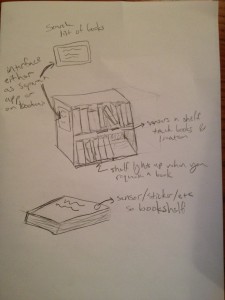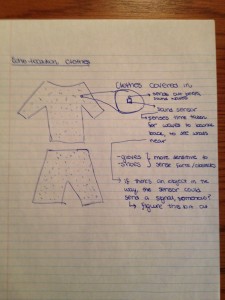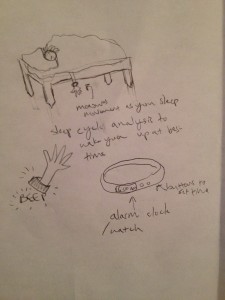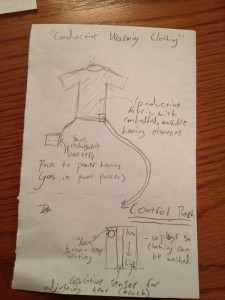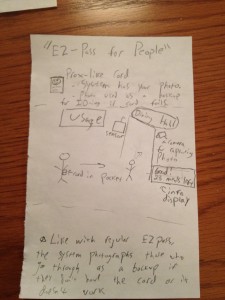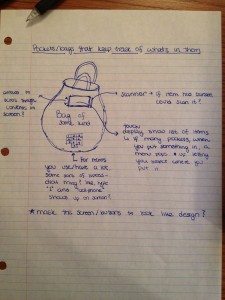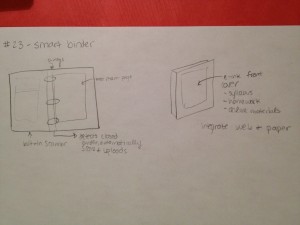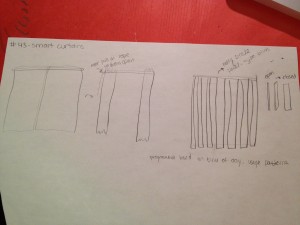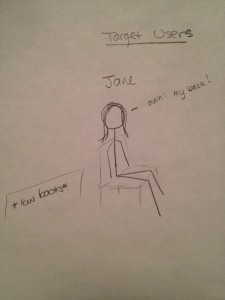Group name: %eiip (everything in its place)
Bonnie Eisenman (bmeisenm), Valya Barboy (vbarboy), Erica Portnoy (eportnoy), Mario Alvarez (mmcgil)
Brainstorming list
- Paper that can erase itself, keep track of changes
- Paper with real-life version control, you can revert it to a previous state, and it includes backups
- Real life version control for room, clothes, etc. organization
- Cheap projector for when you can’t alter your surfaces (for decoration)
- A bookshelf that keeps track of the books on it by using smart book covers or stickers in the books
- Self-adjusting exoskeleton for people who have to stand up for long periods of time (for under your clothes)
- A screen position optimized for a person laying down in bed
- A real-time translator that strips your speech of mean comments and makes them nice
- Clothing or gloves embedded with sound sensors to facilitate echolocation
- Material-free umbrella that repels water using air blowing, possibly.
- Clothing that generates electricity from movement and recharges batteries
- Hackable clothing that converts energy from motion into changing designs (for fashion options)
- A machine that helps you duplicate (scan and print) books licensed under creative commons (or public domain)
- Sleep cycle alarm but not based on phone being in your bed; preferably attached to your body
- Conductive clothing that generates electricity for keeping you warm
- Real-time autotuning for vocal cords
- EZ-pass for real life: getting into dining halls, or even concerts, etc: a system that scans your ID automagically and also photographs people whose IDs aren’t working
- Rigorous rock band vocals where it tells you if you do something wrong, and helps out when you’re doing it wrong (for vocal training)
- Theatre lighting board user interface; automating; virtual stage
- Hair cutting machine like in chitty chitty bang bang
- Pockets or bags that keep track of what’s in them
- 3D printing for clothing
- Smart binder that scans and keeps track of the papers in it, or automatically digitizes them → integrate web and paper → e-ink on binders (you could display the syllabus and everything else)
- Hoods with heaters so you don’t look like a criminal while keeping warm in the winter, or other invisible heated clothing (for face)
- Prox or other chip required to open laundry door in order to prevent theft.
- Robots that automatically declog the hair from your drain.
- Plant that notifies you when the soil is dry
- Litterbox that alerts you when it needs to be cleaned
- A way to alert you when you’re grinding your teeth — a cover for your molar that vibrates etc when you grind your teeth?
- Portable gas chromatographer–mass spectrometer for detecting allergens in air and food
- Flex sensors in gloves to determine how often you’re clenching fists / are stressed, and tell your doctor
- Ping pong balls that record their speeds
- Smart ping pong table that tells you if it’s in bounds
- Chessboards that highlight good next possible moves for teaching
- Cheap nighttime illumination: sticker with light sensor and LED for dark glow
- Convert human body language to text or visual information that can be sent during electronic remote conversation
- Force human hand muscle contraction or flex sensors and motors in a glove to teach sign language
- Force human hand muscle contraction or flex sensors and motors in a glove to teach kids to write
- Portable self-inflicted electroshock conditioning for improving learning speed
- A gestural interface for manipulation of 3D models.
- 3-D mouse for manipulating 3-D models, etc. → possibly using a cube with viscous liquid, or a device with an accelerometer, or hacking an optical mouse (preferably that also works in 3D)
- Curtains / blinds that open and close based on incoming light and normal use patterns (like the Nest does for temperature – save on lighting, help temperature like Icahn)
- Throwing teacher: sensor on object being thrown, calculate what to fix, and inform the thrower. Like frisbee, football.
- Smart clothes that inform you when they don’t match
- RemberRings – small (wearable!) rings that you can use to record to-dos; press a button to record an idea or play back the recording
- GPS + FLORA: embed a GPS in your doggie sweater, so you can keep track of your dog via GPS instead of implanting a microchip, since that freaks some people out. Or, you know, secretly put one in your kid’s jacket.
- Auto-sensing LifeAlert: like LifeAlert, a necklace you wear, but this one measures your pulse, and alerts your doctor and / or family if your heart stops?
- Wearable GPS: tracks your location, points or nudges you in correct direction for your destination. Could be a bracelet, ring, etc.
- Universal car remote to start car and turn on heat
- Bike lock that sabotages bike if you dont unlock it (less bulky than a normal lock, hopefully)
- Wine bottle reusable cork that determines if wine has gone bad (oxygenation sensor?)
- “Windshield wipers” for automatically and quickly erasing chalkboards/whiteboards during a lecture
- A programmable teapot that has the hot water ready for you, based on the time you’ve set your alarm for in the morning.
- A camera that gets facial expressions of kids in classrooms and somehow alerts teacher when class is confused, bored, etc, so that they can adjust speed
Project choice: Biblio-File
To choose our idea, we each picked two ideas from the list, compiled them into a short list, and we cast three votes (indicated by *) each amongst these top 8 ideas (bookshelf****, echolocation***, automatic blinds*, smart binder *, smart bags *, real life EZ pass*, sleep cycle alarm, self-warming clothing*). We chose to implement a bookshelf that keeps track of the books in it. It is an example of embedded computing as it is based around physical books and the shelves they are on, although we may choose to incorporate an application in addition. It addresses a real-world problem, as it addresses the problem of locating, organizing, and keeping track of books, although the problem really extends to physical objects in general. As elucidated below, it has a specific target group of users. We feel that we can create a prototype between now and May, on a relatively limited budget. Many of our other ideas were too large in scope, did not address a problem that we felt actually existed, or simply did not excite us as much.
Target user group
Our target user is a person who owns a lot of books and ideally has some disposable income. Let’s call our target user Jane. She in a sixty-year-old professional with a large book collection, somewhere between 20 and 500 books, and a voracious reader. She has a bit of arthritis and hates searching for books on her bookshelf. She needs to find books quickly, and doesn’t want to waste time micromanaging and organizing her book collection. She also hates “losing” books that she already owns because she can’t be bothered to search through all of her books. We are not really concerned with libraries, which have specific and perhaps idiosyncratic needs, or book collectors, who may be unwilling to modify their books.
Problem description and context
Imagine a person with lots of books. It could be a college student, a professor, a senior citizen, and/or a bibliophile. When the user goes to look for a specific book, it might be time-consuming and very difficult to find. The user might have to bend over, look in the same place multiple times, or even fail to find it. He might not remember whether he put this particular book on his bookshelf at home or in his office. Maybe he lent this book to a friend, and doesn’t even currently have it. The consumer does not really have the time to reorganize his books, and cannot remember where he put what. Our bookshelf would solve these problems by remembering the books that are in it, as well as where on the bookshelf they are, and allowing the user to search for a book in a given shelf. As far as we know, based on Googling the problem, no related or complementary solutions exist already.
Justification of the technology platform
We’ve chosen to use the Arduino microcontroller platform to implement this project. We believe the Arduino is the most appropriate because of its low cost, its ability to interface with low-level electronics (such as our indicator LEDs), and its compatibility with a wide array of sensors. This last is important because we are not yet exactly sure how we will implement sensing the locations of books, and we don’t want to limit our options. Add-ons for the Arduino enable it to have network connectivity (such as this one), which will be needed for the system to look up books based on their ISBN bar-codes. Additionally we need to create an interface for users to input information about the books they’re trying to find, so the system can help them find it. This could be a web app, a mobile app, or even a screen/keyboard built into the bookshelf unit.

